Did you know that some dogs have what’s called a tail pocket? What are tail pockets on dogs?
A tail pocket is a small indentation below a dog’s tail that often looks like a dimple. Like wrinkles, a tail pocket can gather dirt and grime over time possibly leading to infections, so it is important to clean your dog’s tail pocket on a regular basis.
Do all dogs have tail pockets?
No, not all dogs have tail pockets. Dog breeds with a higher likelihood of having a tail pocket are:
- American Bulldogs
- English Bulldogs
- French Bulldogs
- Pugs
Dogs that have no tails, or extremely small stubs of a tail, or corkscrew tails are also often more likely to have a tail pocket concealed underneath the tail. Yet, not every dog listed above is necessarily going to have one. It’s a good idea to check under your dog’s tail with your finger to find out if your pup has a tail pocket.
Should I be worried if my dog has a tail pocket?
The short answer is no, there is nothing to worry about if your dog has a tail pocket. It will just require a little extra care and cleaning. Since it’s a little dimple, it can accumulate dirt and grime, and if not cleaned regularly, could cause problems. Like facial and ear folds, these areas can become irritated, inflamed, and even infected if not cleaned properly.
The tail pocket happens to be a sensitive area and the dog might become tickled as you clean it, so be gentle.
Are there any health issues that are caused by tail pockets?
If your dog has a tail pocket, make sure to clean the tail pocket area to prevent any uncomfortable itchy situations from happening in the future. Many dog owners often fail to notice the tail pocket until it gets infected.
Think of the belly button and how it might smell if it is never cleaned. The same can be said of the tail pocket which encourages the accumulation of dirt, grime, and perspiration slowly but surely.
A horrible stench can be created if the tail happens to block the anus of the animal and this condition can be aggravated by feces and fluids from the anal sac. At times, the tail pockets can develop yeast infections which can lead to a foul-smelling odor too.
How to clean my dog’s tail pockets?
Below, we have provided a few tips on how to clean the infected tail pocket of your furry friend:
1. Wipe down the area
For cleaning, it will be a good idea to make use of a moist paper towel or wet wipes. Remove the dirt from the area after cleaning it carefully and gently. This is a sensitive area, so you need to be quite gentle while wiping it down. Go on cleaning until there is no sign of visible dirt in the area.
2. Make the area dry
It is possible for moisture to develop encouraging the growth of bacteria that can result in infection. Pat the area with a dry towel to soak up any moisture.
3. Take preventative steps
The tail pocket can get infected easily, and therefore, it will be advisable to use a diaper rash cream if it gets infected. A small quantity of the ointment can be applied to the infected area meticulously and a thin layer will be enough. It’s also advisable to take your dog to the vet if you do see an infection developing in the tail pocket area.
A lot of dog owners are not aware of the tail pocket and they only find it once the area gets infected. In that case, a filthy odor or sticky stuff might come out from the area. If that happens, make it a point to talk to the vet before trying to treat it on your own.
How to find your dog’s tail pocket?
It is possible for the puppies not to develop tail pockets until they become six months old or older.
In order to see if your dog has a tail pocket, gently stick your finger beneath the tail of the dog. If you feel a small dent, then that is the tail pocket. Most dogs might be somewhat ticklish when you do this, so be gentle. While you rub the finger in and around the spot, you might find some lose dirt and hair. This is a sign that some cleaning is needed!
Although tail pockets are small, they can could cause significant problems for a few dog breeds including bulldogs if not looked after and cleaned properly. Look out for tail pockets in your dog once they turn six months of age or older. The tail pocket can become infected in the long run due to the accumulation of grime, dirt, and sweat. Fortunately, you can prevent this from happening by making use of wet wipes for cleaning the area and using a soft piece of clean cloth for drying the region properly.
